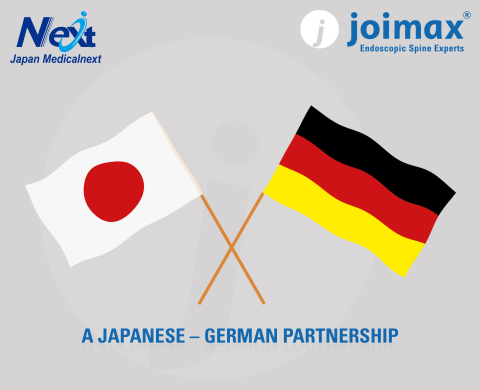KARLSRUHE, Germany--(BUSINESS WIRE)--joimax®, the German-based market leader in technologies and training methods for full-endoscopic and minimally invasive spinal surgery, is starting, as of now, a new partnership in Japan. The distributor JMC-JAPAN MEDICALNEXT CO., LTD. and joimax® are pursuing a long-term sales cooperation that will result in an extensive distribution agreement for the entire Japanese market.
“joimax® is looking forward to working with a partner as strong as JMC,” says joimax® Founder and CEO Wolfgang Ries. “JMC is a company that has the necessary personnel, expertise, as well as the corresponding specialization and penetration of the market.” Masayuki Yoshimura, President and CEO of JMC, explains, "We are very excited to partner with joimax®. With our shared vision for advancing the field of minimum invasive spinal surgery, we are looking forward to introducing the globally recognized joimax® products in Japan." Thus, joimax® strengthens its sales activities in Japan and enters into another important partnership in Asia.
JAPAN MEDICALNEXT CO., LTD., founded in 1992, is located in Osaka, Japan. With 314 employees at its locations, and an Orthopedics Division that will focus on joimax® products, the company is a wholly owned entity of MC Healthcare, Inc. (subsidiary of Mitsubishi Corporation) and prominent supplier of medical devices in Japan.
About joimax®
Founded in Karlsruhe, Germany, in 2001, joimax® is the leading developer and marketer of complete systems for full-endoscopic and minimally invasive spinal surgery. With the Endoscopic Surgical Systems TESSYS® (transforaminal), iLESSYS® (interlaminar) and CESSYS® (cervical) for decompression procedures, MultiZYTE® for facet and sacroiliac joint pain treatment, EndoLIF® and Percusys® for minimally invasive endoscopically assisted stabilizations, established systems are provided, addressing a whole range of indications.
In procedures for herniated disc, stenosis, pain therapy or spinal stabilization treatment, surgeons utilize joimax® technologies to operate through small incisions under local or full anesthesia, via tissue and muscle-sparing corridors and through natural openings in the spinal canal, e.g. the intervertebral foramen, the so-called “Kambin triangle.”




